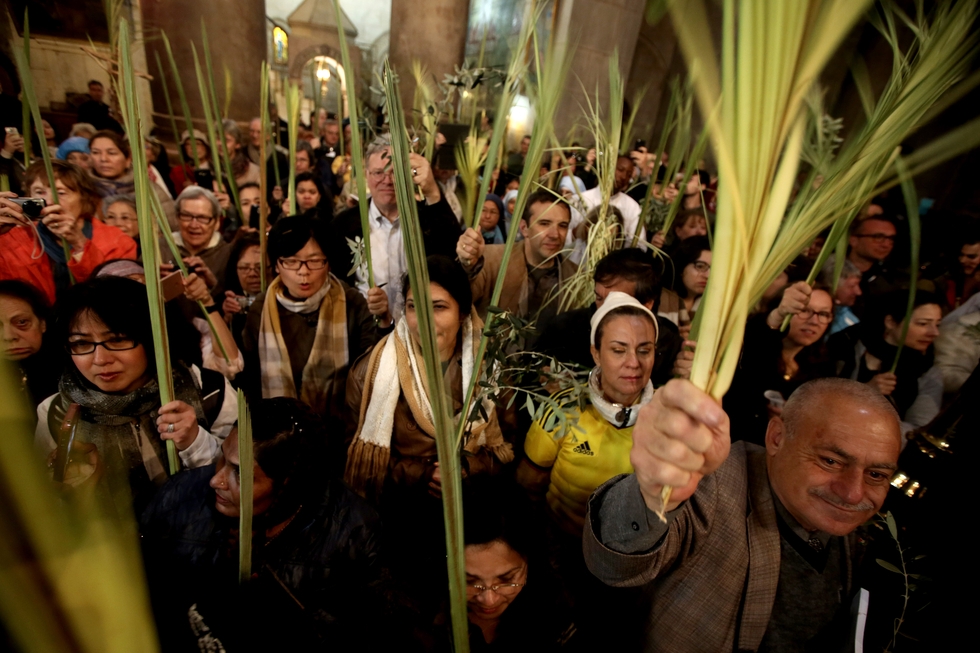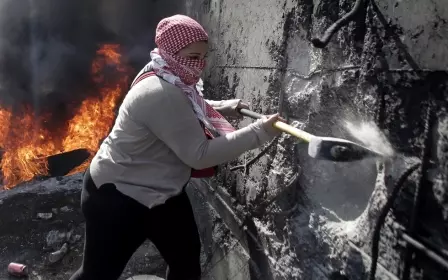Christians visiting Holy Land for Easter ignore reality on the ground

Christian pilgrims from across the world on Sunday began landing at Ben-Gurion Airport for a unique religious experience: Easter celebrations in Israel.
The celebrations started on 20 March, when Christian pilgrims climb the Mount of Olives to re-enact the entry of Jesus Christ into Jerusalem, and end on Easter Sunday, when Christians commemorate the resurrection of Jesus Christ.
But this traditional pilgrimage does not take place in a political vacuum. Israel promotes tours to the Holy Land to Christians in America and Europe as part of its international outreach.
On 15 March at a promotional event at the Casino de Madrid in Spain, the atmosphere was strangely quiet. Only about 30 people attended and the Israeli ambassador to Spain left early.
The conference was mainly focused on promoting Israel as a safe destination for Spanish pilgrims. Nobody spoke about the occupation. Nobody spoke about the inequality of law enforcement in the Palestinian Territories. Nobody spoke about recent wave of attacks in Israel and the occupied West Bank.
After Easter, Christian pilgrims will return from the Holy Land to their home countries, many of them unaware of the actual reality on the ground; few of them will visit the West Bank, and none will enter the Gaza Strip.
This reality is complex: Israel occupies part of the West Bank, where illegal Jewish settlements mushroom; and Palestinians living under occupation face multiple challenges, including an inequality of law enforcement in their land.
For their part, Palestinians living in the Gaza Strip feel imprisoned. With around 1.85 million Palestinians living on some 362 square kilometers, Gaza ranks among the most densely populated areas in the world.
Also, its infrastructure has been severely affected by the most recent Israeli military assault in 2014.
Meanwhile, attacks against Israelis occur frequently. These attacks are either perpetrated by militants in the Gaza Strip, who launch rockets into Israeli territory, or perpetrated by "lone wolves" who operate within Israeli territory.
Unfortunately, many Christian pilgrims will not become acquainted with this complex reality. Their trip to the birthplace of Christianity will be of limited dimensions.
The reality for the Palestinians
Hamde Abu Rahma risks his life on a daily basis. Armed with a camera, he documents Palestinian life under Israeli occupation. Following the death of his cousin Phil, which is featured in the award-winning documentary Five Broken Cameras, he decided to start working as a photojournalist: “My mother does not like when I go to work; two of my cousins were killed this way.”
Christian pilgrims will return home clueless about Hamde’s reality and that of other Palestinians living under Israeli occupation.
Tours to the Holy Land are usually catered to by Israeli agencies that employ Israeli guides who recite the Israeli official narrative of both historical and current events.
This narrative excludes the fact that there is an inequality of law enforcement in the Occupied Palestinian Territories (OPT), for example.
According to international humanitarian law, the State of Israel, as the occupying power in the OPT, is responsible for ensuring the security and safety of Palestinian residents in this area.
Nevertheless, Israeli forces fail to protect Palestinian civilians and their properties from settler violence, and rarely detain Jewish settlers who have committed crimes against Palestinian civilians.
Consequently, settler violence against Palestinians and Palestinian property is often perpetrated with impunity.
Furthermore, Palestinian residents in the West Bank are subject to Israeli military law, while Jewish settlers enjoy the legal safeguards provided by the Israeli civilian judicial system.
In addition, Palestinian offenders as young as 12 can be interrogated without the presence of an adult representative, and even imprisoned.
On the other hand, the Israeli civilian judicial system protects Israeli minors during the criminal justice process under Amendment Number 14 of the Youth Law, which prohibits the incarceration of minors under the age of 14, and entitles Israeli minors to have their parents or an adult representative speak on their behalf during interrogation.
Also, Palestinians living under occupation face an alarming rise in demolitions and displacement within the West Bank, as well as an increase of Jewish settlements.
In February 2016, Israeli authorities dismantled 237 Palestinian homes and livelihood-related structures across the West Bank – the highest figure in a single month since the Office for the Coordination of Humanitarian Affairs of the United Nations began to systematically document the impact of demolitions in 2009.
Most of the structures were destroyed on the grounds that there was no building permit. These permits are almost impossible to obtain.
Moreover, this month, the Israeli organisation Peace Now released new data indicating that in 2015 construction started on 1,800 new settlement housing units, fewer than in 2014, but more than in the previous two years.
Christian pilgrims will discover very little about this reality by the end of their trip. Most of them will avoid visiting the West Bank due to security concerns, and those who do, will only visit the town of Bethlehem, the birthplace of Jesus Christ.
None of them will enter the Gaza Strip, as visiting the enclave is not permitted to tourists. They will not witness first hand the destruction that followed the latest military operation.
The reality for the Israelis
Israelis live under constant fear of attack, particularly in the southern Israeli cities of Ashkelon and Sderot.
When militants in the Gaza Strip launch rockets into Israeli territory, the early-warning radar Tzeva-Adom or Colour Red installed in the Israeli towns surrounding the Gaza Strip warns civilians of an imminent attack by rockets. When the alarm pounds, Israelis have seconds to find shelter.
These attacks are frequent. Still, Christian pilgrims rarely experience them first hand, as southern Israel is not usually part of their travel itinerary.
It was not until I lived in the southern city of Be’er Sheva, which is located in the middle of the Negev desert, that I myself became acquainted with this reality.
For me, as for the majority of visitors to Israel, this reality is not normal. Yet this reality is part of daily life in southern Israel.
In addition to rocket attacks, Israelis face another security challenge: lone wolf attacks, which are difficult to predict, and, consequently, difficult to thwart.
The latest wave of violence, which started in October 2015, continues until this date.
In the first two months of 2016, four Israelis and 27 Palestinian suspected perpetrators were killed during attacks or alleged attacks by Palestinians. Another seven Palestinians were killed and over 1,000 injured during protests and clashes.
Christian pilgrims mainly know of these attacks through the media. Despite the fact that they are visiting the country where these attacks are taking place, this reality is distant from them.
The full picture
At the conference in Madrid, a Spanish journalist stated: “It is time to stop idealising Israel as a destination for Christian pilgrims. We, Christians, need to experience the realities on the ground. Instead of portraying Israel as an ideal destination for Christian tourists, we need to address what is happening on the ground, and encourage prospective visitors to not turn a blind eye on the situation there.”
Indeed, it is time for Christian pilgrims to widen the spectrum of their trip to the Holy Land. They can start doing so this Easter.
- Tania Ildefonso Ocampos is a Spanish political analyst who specialises in EU strategy in the Middle East. She is a former Schuman trainee (Euro-Med and Middle East Unit of the European Parliament's Directorate-General for External Policies), and holds an MA in Middle Eastern History from Tel Aviv University, Israel.
The views expressed in this article belong to the author and do not necessarily reflect the editorial policy of Middle East Eye.
Photo: Catholic pilgrims carry palm branches as they circle the aedicule during the Palm Sunday procession at the Church of the Holy Sepulchre in Jerusalem's Old City on 20 March, 2016 (AFP).
Middle East Eye propose une couverture et une analyse indépendantes et incomparables du Moyen-Orient, de l’Afrique du Nord et d’autres régions du monde. Pour en savoir plus sur la reprise de ce contenu et les frais qui s’appliquent, veuillez remplir ce formulaire [en anglais]. Pour en savoir plus sur MEE, cliquez ici [en anglais].





